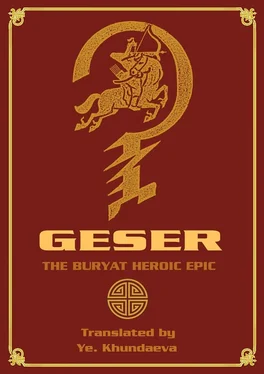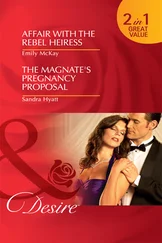Ye. Khundaeva - Geser. The Вuryat heroic epic
Здесь есть возможность читать онлайн «Ye. Khundaeva - Geser. The Вuryat heroic epic» — ознакомительный отрывок электронной книги совершенно бесплатно, а после прочтения отрывка купить полную версию. В некоторых случаях можно слушать аудио, скачать через торрент в формате fb2 и присутствует краткое содержание. ISBN: , Жанр: Языкознание, foreign_language, на английском языке. Описание произведения, (предисловие) а так же отзывы посетителей доступны на портале библиотеки ЛибКат.
- Название:Geser. The Вuryat heroic epic
- Автор:
- Жанр:
- Год:неизвестен
- ISBN:9785448558627
- Рейтинг книги:3 / 5. Голосов: 1
-
Избранное:Добавить в избранное
- Отзывы:
-
Ваша оценка:
- 60
- 1
- 2
- 3
- 4
- 5
Geser. The Вuryat heroic epic: краткое содержание, описание и аннотация
Предлагаем к чтению аннотацию, описание, краткое содержание или предисловие (зависит от того, что написал сам автор книги «Geser. The Вuryat heroic epic»). Если вы не нашли необходимую информацию о книге — напишите в комментариях, мы постараемся отыскать её.
Geser. The Вuryat heroic epic — читать онлайн ознакомительный отрывок
Ниже представлен текст книги, разбитый по страницам. Система сохранения места последней прочитанной страницы, позволяет с удобством читать онлайн бесплатно книгу «Geser. The Вuryat heroic epic», без необходимости каждый раз заново искать на чём Вы остановились. Поставьте закладку, и сможете в любой момент перейти на страницу, на которой закончили чтение.
Интервал:
Закладка:
Such episodes are quite typical for the Buryat epic. One can recall some Mongolian epical motives of the destruction of the enemy’s soul located in the three bees, in the plume of the Kherdig bird, in the toad, in the mangus’ mother’s box, the transformation of the soul into the quails, the roe deer and the hero pursuing them in the form of a hawk, a wolf, etc. Mentioned as the soul keepers are the knotted larch, perch, bull, wolf, fox, frog, birds like the quail, falcon, crow, eagle. Then there might be the snake, the fish, the goat, the ram, spider, the stallion, the lion, the mule, the Kherdig bird’s plume, the thread, the needle, the gold.
One should mention the existence of the cult of the mountains, prayers on the mountain, begging for children and the birth of the child from a mountain spirit. If the necessity arose to move the stones from one place to another it was advisable to complete certain rituals to appease the spirit of the mountain. The relics of such consciousness may be observed in our days too. As we have already mentioned there are the totemic features fairly well preserved in the epic. In a Khori genealogical legend of Khoridoi-mergen the hero gets married to a celestial fairy that had formerly been a bird. Very well known is the motive of the swan, the ancestor of one of the Buryat tribes. In the Mongolian epic of Geser the two bulls are shown as fighting, one of them being white, the other black. The white one is taken to be the protector of Geser, the black of the mangus. The totemic ancestors of the Bulagats and Ekhirits are the grey Bukha noyon bull, the black and white bull. This motive has its parallel in a Tibetan legend, describing the fight between the white and black snakes that come out of the mangus’ nostrils or in the Tibetan version of the Geser epic where the two snakes fight having come out of the mangus’ ears.
The nomad tribes of Central Asia left the monuments resembling the “deer stones” or the stone slabs with the engraved inscriptions, magical formulas. In Transbaikalia and Mongolia they found the sacral writings on rocks, the so-called rock paintings or petroglyphs on which depicted most frequently was an eagle in flight. They date back to the second half of the second millenium B. C. They all are of the conventional nature and are given as symbol or sign. There is much in common between the drawings mentioned and the zurags on the Balagan ongons (mascot, amulet). The ongons are the symbols of the ancestors’ spirits and the eagles are also thought to be the spirits of the ancestors. The Baikal region is abundant in the legends of the genealogical totems depicted in the form of a flying eagle. According to those legends the host of the Oikhon (Olkhon) island on the Baikal, married a tengri’s daughter. She gave birth into a son, Burged by name which means “eagle”. He adopted the eagles as sons. The latter gave the beginning to the kin of the Ol’khon shamans who were known as the shubuuni noyod (lords of birds). They say that earlier during the sacrifice ritual to Khan Khoto Babai they made the three replicas of the eagles from the birch bark. There are the beliefs that the eagle was a shaman. One can come across his image everywhere. We might just mention in this respect Khan-Garudi. Garudi came originally from India perhaps via Tibet, its image might have intermingled with that of the eagle, the cult of which is so widely spread in Buryatia.
The heroic epic of the Mongolian tribes is rich in the other diversified mythological elements. One could mention the demons that appeared out of the remnants of the evil deities thrown down to the Earth. Geser has the reputation of the destroyer of the demons and monsters, the personifications of the dark chthonic forces. The epic tells of the Tengris coming down to the Earth, of the middle place between the Sky and the Earth, of the dragons, of the various monsters such as mangadkhais, manyheaded snakes, birds, huge dogs, frogs, ants. The fantastic images reflect the mythological essence of the epic and hence its archaic shamanic nature. The cosmic elements are widely presented in the epic of the Mongolian tribes. They are the Sky, the Sun, the Moon, the stars, the Earth, the water, etc. To this may be added the cosmogonic prologue of the Geser epic. In the Kalmyck “Djangar” the main character gets married to a celestial girl. Geser is often given help by his three celestial sisters. Presented also is a solar motive. The conception of a child is associated with a golden pole of light coming through the upper hole of the yurt.
The performing of the “Geser” epic was of ritual, magic, shamanic nature. The epic-tellers sank into trance when performing the epic. The epic was used by the shamans for exorcising the evil spirits. This is reflected in the shaman practice, in the invocations. Geser is taken to be the son of the Tengri (Heaven). Sometimes the Earth and Water are regarded as Geser’s parents, this fact is associated with the shaman ideas of the human personification of the souls of the mountains and localities. Reciting of the uliger appeases the spirit of the Master of the taiga (thick forest) and helps in hunting. A folklore performer himself was in fact a shaman or is now a peculiar type of shaman.
The natural phenomena and the epical heroes
According to the epic the people are deeply affected by the natural phenomena. To be more exact, this all reminds of some of the features and deeds of the main character of the Buryat epopee “Geser”. He gives an impression of being quite often an emotional and caring personality in his attitude to his family, relatives, kinsmen, motherland and nature. All his deeds are closely connected with the natural forces and phenomena. The heroic epic of the Buryat people narrates of the noble deeds of Geser liberating the people from the evil, of his battles with the monsters that would not let people live in peace and harmony. Not infrequently those monsters-mangadkhais personified the powerful, threatening forces of Nature that were beyond understanding of the common folk. They were quite unaware of the origin and the cause for their being sometimes quite merciless. Therefore those powerful forces were taken as, say, Gal-Nurman Khan who was the symbol of one of the prime elements, i.e. the Fire, the oppressive heat and drought. One might recall Loir Lobsogoldoi who was the personification of another prime element, i.e. the water, flood and overflow that badly damaged and injured the people, animals and plants. One could add here monster Orgoli who was taken as Master of the taiga (thick forests) and could deprive hunters of their game or sometimes took up their lives. Then there was Shereem Minata khan with an iron whip and a pig iron thigh who possibly symbolized the starting point of the blacksmith shop, the first steps in mastering the art of forging. The sparks and flames coming from the glowing metal were perceived by the ancient forefathers of the Buryats as a threatening iron whip which might burn or dazzle. One might as well recall the epical devil Arkhan who wanted to swallow the Sun and the Moon and plunge the Earth into the darkness. This might be the symbolical representation of the Sun and the Moon eclipse in the perception of the ancient Buryats.
On the other hand, the Buryat epic sings glory to the same natural prime elements. Not only do those forces of nature harm the people but they also do them a lot of good. Man could not do without the fire, water, gifts of the thick forests including wood, plants, game, etc. Man realized it too well. He felt that the fire, water, forest, stone, metal possessed the positive qualities too. They helped him survive There was more favourable for him in those objects than negative. So he worshipped them, took them to be sacral. Hence there are the many cults, that of the Sky, for example, though it sent down to the Earth the thunderstorm and lightening, heavy rain and floods. There was the cult of the Sun and the Moon that is closely connected with the light, heat, warmth and fire. One cannot but mention the cult of the Water, lakes and rivers, as well as the cult of the Master of the taiga that provided the Man with the food and wood. There were many other cults. Since there were the sacral cults there certainly were the cult rituals, the sacral ceremonies which were to plead the divinities to help the man prosper and protect him from the evil spirits. Each hardship in life was thought to be directly connected with the unkind spirits whom it was needed to keep away with help of the deities. This double nature of the earthly and the cosmic elements interfering with the life of man was the reason for the emergence of the pantheons of the gods and deities. They had the special names and were in charge of the specific meteorological and the other phenomena. Naran Gerel tengri was in charge of the sunny days. Oyor Sagan tengri was in charge of the cloudless weather. The following divinities come the first among the rest of the Heavens according to their role and status: Yekhe Ekhe tengri (Great Mother the goddess), the eldest gods Manzan Gurme and Mayas Khara, Esege Malan tengri (the bald-headed or cloudless Sky) and idle, careless Khormusta tengri, Altai Ulan who represents the older generation of the deities, Zayan Sagan tengri (The White Creator). The sense and cult perception of the world made the Buryat people depict the epical personages either as men with some extraordinary features (the anthropomorphous creatures) or animals with the exaggerated grotesqueness (the zoomorphous creatures) or just the mixed types bearing the features both of human being and animal (the mixmorphous creatures). One can understand why it was so. The powerful forces excited the fear and shock so that the people gave those inexplicable phenomena like the lightning some fantastic mysterious coloring.
Читать дальшеИнтервал:
Закладка:
Похожие книги на «Geser. The Вuryat heroic epic»
Представляем Вашему вниманию похожие книги на «Geser. The Вuryat heroic epic» списком для выбора. Мы отобрали схожую по названию и смыслу литературу в надежде предоставить читателям больше вариантов отыскать новые, интересные, ещё непрочитанные произведения.
Обсуждение, отзывы о книге «Geser. The Вuryat heroic epic» и просто собственные мнения читателей. Оставьте ваши комментарии, напишите, что Вы думаете о произведении, его смысле или главных героях. Укажите что конкретно понравилось, а что нет, и почему Вы так считаете.











